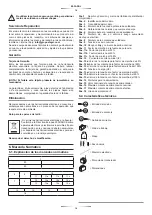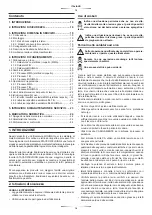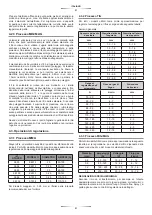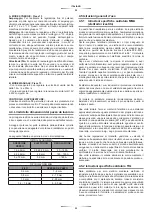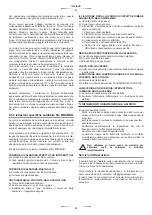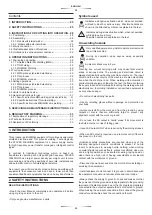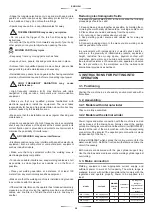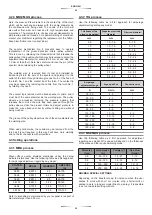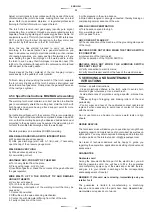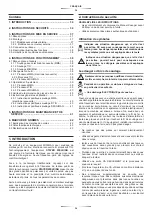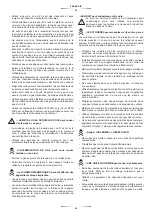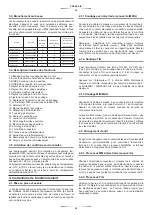
26
26
ENGLISH
• Keep supply cords free of oil and fat, and protected from hot
metal and sparks.
• Inspect power input cord frequently regarding damage or bare
cable. Replace cord immediately if damaged – a bare cable may
kill you.
• Switch off the whole equipment when you are not using it.
• Do not use cables which are worn-out, damaged, very small-
sized or wrongly connected.
• Do not wrap cables around your body.
• A grounding clamp is required for a work; make a ground
connection using a separate cable.
• Do not touch the electrode when you are in contact with the
work or the grounding circuit or another electrode of a different
machine.
• Do not put into contact two electrode carriers that are connected
to different machines at the same time, because in that case
there will be open-circuit double voltage.
• Use equipment in a well-maintained condition. Repair or replace
damaged parts immediately. Maintain the unit in accordance
with the manual.
• Use safety braces to prevent it from falling down when working
above floor level.
• Keep all panels and covers in place.
• Put the clamp of the work cable in good metal-to-metal contact
to the work or the work table as close as possible to the weld as
it is practical.
• Keep or isolate the grounding clamp so that there is no contact
with any metal or any grounded article.
• Isolate the grounding bracket when not connected to the
workpiece to avoid it contacting any metal article.
HOT PARTS may cause serious burns.
• Do not touch hot parts with your hand without glove. Allow that
there is a cooling period before working at the machine.
• To handle hot parts, use appropriate tools and/or put on heavy
gloves, with insulation for welding and clothing to prevent burns.
SMOKE and GASES may be dangerous.
Welding produces smoke and gases. Breathing in these gases
and smoke may be dangerous or mortal.
• Keep your head out of the smoke. Do not breathe in smoke.
• When you are indoors, ventilate the area and/or use forced
local ventilation in front of the arc to withdraw welding smoke
and gases.
• When ventilation is use an authorized respirator.
• Read and understand the Data Sheets on Material Safety
(MSDSs) and the manufacturer’s instructions regarding
materials, consumables, coatings, cleansers, degreasing agents
and any other chemical products.
• Do only work within a closed space if it is well ventilated or
while using an air respirator. Always have near a trained person.
Welding smoke and gases may displace air and reduce oxygen
level causing harm to health or death. Make sure that air for
breathing is safe.
• Do not wed at locations near to operations involving grease,
cleaning or paint spraying. Heat and bolts of the arc may react
with vapors and form strongly irritating and toxic gases.
• Do not weld on coating materials such as galvanized steel,
lead, or cadmium-coated steel, unless the coating has been
removed from the welding area, the area is well ventilated and
while using a respirator with a source of air. Coatings of any
material containing these elements may cause smoke being
emitted when welding.
BOLTS EMITTED BY THE ARC may burn your eyes
and skin.
Bolts emitted by the arc of a welding process produce intense
heat and strong ultraviolet rays that may burn eyes and skin.
• Use an authorized welding mask having a lens-filter shade to
protect your face and eyes while welding or looking, cf. safety
standards ANSI Z249.1, Z175, EN379.
• Use authorized safety goggles having lateral protection.
• Use protective screens or barriers to protect others from
flashes, reflections and sparks; alert other not to look at the arc.
• Use protective clothing made of durable, flame-resistant
material (leather, thick cotton or wool) and protection to your feet.
WELDING may cause fire and explosion.
Welding a closed container such as tanks, drums or tubes may
cause explosion. Sparks may fly from the welding arc. Flying
sparks, the hot workpiece and the hot equipment may cause fire
and burns. Accidental contact of the electrode with metal articles
may cause speaks, explosion, overheating, or fire. Check and
make sure that the area is safe before starting any welding.
• Withdraw any inflammable material from within a distance of
15 m of the welding arc. When this is not possible, cover it tightly
with authorized covers.
• Do not weld where sparks may impact on inflammable material.
Protect yourself and others from flying sparks and hot metal.
• Be alert to weld sparks and hot materials from the welding
operation may pass through small cracks or openings in adjacent
areas.
• Always watch that there is no fire and keep near an extinguisher.
• Be alert to that, when welding a ceiling, floor, wall or any kind
of separation, heat may cause fire at a hidden part which cannot
be seen.
• Do not weld within closed receptacles such as tanks or drums
or piping unless they have been prepared appropriately in
accordance with AWS F4.1.
• Do not weld where the atmosphere might contain inflammable
dust, gas or vapors from liquids (such as gasoline).



